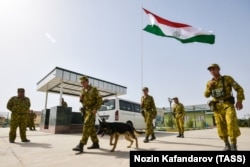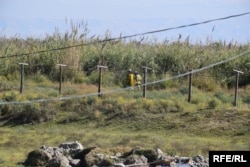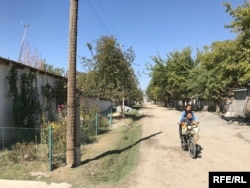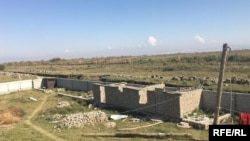KHAYOM, Tajikistan -- When the night falls in Khayom, the entire village disappears into the darkness.
Residents of this Tajik settlement on the northern banks of the Panj River have learned not to turn their lights on at night -- at least not until their windows are blacked out with thick, dark curtains. Doing otherwise, they are told by guards who patrol the nearby border, could attract gunfire from the other side.
Everyone knows that Afghanistan's northern Takhar Province lies past the river that demarcates the border. Signs and guard towers dot the "exclusion zone" -- a strip of no-man's land that ranges from two meters to two kilometers wide -- that runs along the border, making it clear they are supposed to be wary of some unseen danger. But other than that, there is only a vague understanding of what lurks beyond.
"I often wake up with the braying of donkeys from the Afghan side in the morning," says one Khayom villager, who declines to give his name. "It usually starts around 4 a.m., then I can hear the sound of motorcycles. It seems people there wake up much earlier than us."
Whoever they are, the neighbors are blamed for a number of local afflictions -- everything from wild boars and invasive insects to drug dealers and random acts of violence.
Nocturnal Munitions
It's the nightly sound of gunfire and the sound of stray bullets whizzing by, occasionally pinging off unseen targets, that stands out to many living on the border -- at least it used to.
"After living here for a decade, I’m used to hearing gunfire," local resident Bekmurod Zardakov says. "But guests visiting from other towns can’t fall asleep because of it.... It terrifies them."
Some here describe their existence as living in a peaceful country near the frontline of somebody else's war.
Amid warnings from Dushanbe about the prospect of Islamic militants entering the country, and news that the Afghan government has lost control of large swathes of its territory to its main militant adversary, many point simply to "the Taliban" as being responsible for locals' unease.
Taliban militants, successors to the former regime that was ousted in 2001 by a U.S.-led invasion, have seized dozens of villages near the Tajik border in recent years, several of them across from Khayom and its governing district, Farkhor. All in all, Tajik authorities estimate that at least 300 kilometers of the countries' shared 1,360 kilometer border are not controlled by Kabul's forces, and Tajik border troop commander Rajabali Rahmonali estimated in early 2018 that 7,000 Taliban militants were concentrated near Tajik territory.
But the traditional Taliban is not known for exporting its fight and is not the only Afghan government foe active across the Tajik border. Islamic State and IMU fighters, as well as drug runners and other criminals, are present as well, and contribute to the feeling of uncertainty. The withdrawal in 2005 of Russian troops, which had defended southern Tajikistan following the fall of the Soviet Union, has added to the scrutiny of Tajikistan's ability to defend its border with Afghanistan.
Shells, Bullets, And Boars
Things are not much different outside the confines of Khayom. The fear factor is alive and well on the Barzgar farmland that lies on the town's outskirts.
One morning last June, local farmer Saidabdullo Nematzoda says, a group of women tending to the cotton fields narrowly missed being hit by an artillery shell and several bullets that landed nearby.
Responding to a statement from the Tajik government, Afghan officials said at the time that the shell and bullets were fired by the Taliban, but locals remain unconvinced.
"We don't know who fired those shots," Nematzoda says. "Nobody ever gave us any explanation. And there is no guarantee that there won't be another similar incident."
The lack of governance on the southern side of the Panj River fuels many rumors.
Nematzoda singles out crop pests, a major nuisance that threatens local farmers' livelihood.
"We use pesticides and other methods against the insects that destroy the crop, but this needs to be done in coordination with all farmers in the area," Nematzoda says.
No stability across the river means no coordination.
"Pest control doesn’t bring much results if your neighbors don’t take any action. Insects keep coming from the other side of the border and infesting our lands," he claims.
The lands of Barzgar are also plagued by hordes of wild boars that trample on crops, Nematzoda says as he points to land apparently dug up by the animals. He claims, without providing evidence, that they come from Afghanistan.
And The Drug-Runners...
The porous border alongside the Panj River has long been used by drug smugglers who traffic narcotics from Afghanistan, the world’s largest producer of opium. Opium makes its way out of Afghanistan through well-established routes and is processed into heroin, after which it makes its way to Western Europe, Russia, and the world at-large.
Some of those routes run through Tajikistan, and several local residents have been accused of involvement in the trade, with tales of family members of some being taken hostage by Afghan drug suppliers due to unpaid debts.
Residents in the Farkhor and Hamadoni districts are tightlipped about villagers’ involvement in the drug dealing, however.
"All I know is that such incidents have decreased in recent years," one local man says.
There are no official statistics about the number of shoot-outs Tajik border guards have engaged in with drug smugglers and other infiltrators, but they often take place in full view of those who live near the border.
One incident in December 2017 saw a Tajik colonel, Khairiddin Ahtamov, lose his life and four others suffer wounds during an exchange with suspected Afghan drug traffickers.
In Chubek, a border village 60 kilometers north of Khayom, residents mourn the loss of Umedjon Hasanov, a 27-year-old border guard who was killed in an ambush by suspected Afghan traffickers in October 2016.
The soldier was shot dead in the first month of his military service in his home district, his father Hakim Hasanov says.
In August 2018, a group of a dozen armed men infiltrated into Farkhor and killed two civilian residents: a forest ranger and a farmer. A third man was taken to the hospital with gunshot wounds. The attack, the identities of the infiltrators, and their motives remain unknown.
Gloom With A View
There is not much that can be done about the unrest beyond. "What goes on the other side of the border is beyond our control," admits Olimjon Amirshoev, the deputy head of the Villages Council that oversees several rural settlements in Farkhor district. "It's another country."
But efforts are under way to address the issue on the Tajik side. Authorities in the Farkhor and Hamadoni districts say they are working on a project to relocate residents of border villages to other regions within southern Khatlon Province, although they stress that the details are still being worked out.
"We hear such promises from time to time, but nothing concrete yet," says Gulrukhsor Faizulloeva, whose modest, one-story house is located some 100 meters from the exclusion zone.
Faizulloeva expects the government to provide locals with housing and proper financial compensation as part of any relocation project.
"I don't see it happening anytime soon," Faizulloeva says. "I don't know if the government has enough money for that."
One man, the Khayom villager who wakes to the sound of braying Afghan donkeys, says he has had enough but has no options.
After investing all his savings into a home just a stone's throw from the exclusion zone, the 30-year-old construction worker says he has no hope of finding a buyer and cannot afford to simply leave.
He was attracted by the cheap land prices, green surroundings, and arable soil, but says that "when I bought it, I didn’t know what living here entailed."
The large windows of the house provide clear views of the border guards who patrol just beyond the wire security fencing that marks the beginning of the exclusion zone.
"It could make a good summerhouse, but it’s not a place to you’d want to live full-time," the man says.













